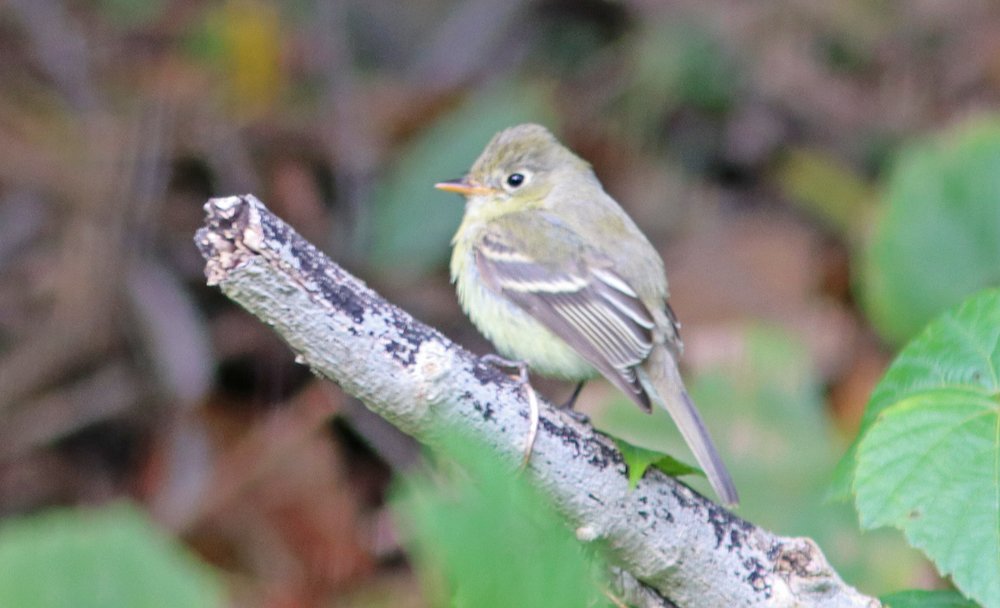
Late Sunday afternoon I was relaxing at home trying to recover from my early awakening due to having turned back the clock one hour for daylight saving time. Well, that and over imbibing on Halloween candy, if I’m being honest. I mindlessly opened my phone and scrolled through Facebook…and an image jumped out at me, an image of a flycatcher from Kissena Park in my home borough, a flycatcher I had never seen in Queens, a flycatcher so obscure that I couldn’t even identify it.
What? I couldn’t identify it? That’s right, and neither could the person (Michael Gottlieb) who posted the photo, taken the day before, on Halloween morning. He had posted it to “What’s This Bird?” a popular group in Facebook where novice birders can post photos of the birds they see and hope others will identify the birds for them. He thought it might be an Acadian Flycatcher but was not sure. He was wise not to be sure because quite a few knowledgeable birders quickly pointed out that the bird was a “Western” Flycatcher. Awesome, right? A new bird for Queens!
“But,” some of you might ask, “Why the quotation marks around ‘Western?’”
I’m glad you asked! “Western” refers to a two-species complex, the Cordilleran Flycatcher and the Pacific-slope Flycatcher. They are essentially indistinguishable in the field unless you get amazing recordings of them and even then you can’t be sure. What you really need to do is see them in their home range, which, seeing as the bird was in Queens, was not really possible.
Also, I wasn’t seeing the bird at all. It was pouring out and rapidly getting dark and there was no way I was going out and finding that bird on Sunday evening. But Monday morning was a new day and I was up and out of the house early and at Kissena Park before 7AM. And I couldn’t find the bird. And the few other birders couldn’t find the bird. And, eventually, I had to give up and get home so I could start doing some work.
“Wait,” those of you who are more astute might ask, “If you missed the bird then where did the picture at the top of this blog post come from?”
I’m glad you are paying attention! I got home and within minutes my phone was blowing up with word came that the bird had been refound by Robert Proniewych. So, of course, I managed to find a bit more time before I really had to start work and I headed back to the park where the bird was quickly in my binoculars. But we – and by we I mean the crowd of birders that had swelled quite a bit from the lonely three birders looking early in the morning – still had the issue of not knowing what species we were actually looking at! What could we do?
Fortunately, the bird pooped. Why was this fortunate? Because one lucky birder got to collect the poop with the hope it can be used to get the bird’s DNA and that way we’ll know what we saw, provided we can find a lab that will do the work and hasn’t closed due to COVID. Oh, and I was the lucky birder who collected the poop. Birding is so sexy sometimes.
Seriously though, the “Western Flycatcher” in Central Park in 2015 was only definitively identified as a Pacific-slope Flycatcher after its poop was collected and the DNA analyzed. My old pal Rich Guthrie has the tale of that bird, which I saw but somehow never blogged about.
No matter what species it turns out to be it will be new to my Queens list: even if we never identify it to species it will take up one spot on the checklist as something new. I kind of like not knowing but if a second “Western” Flycatcher ever shows up in Queens I would definitely like to know what this one is so I’d have a chance of seeing both species in Queens!













Did you ever find out what it was?
Cesar: It was a Pacific Slope Flycatcher.
Corey…Your bird is a Corderilleran Flycatcher!!! If there was a way for me to send you a photo and an email from an ornithologist from Cornell – I would send you a photo of our Corderileran flycatchers! We named her OLIVE, and she has been coming back using a nest on the top of our outside front door light for the past SEVEN years! In fact, she is out there now sitting on top of her eggs – usually three. I have photos of babies hatching and leaving the nest. They are the most darling, happy birds. How they know to fly back to the mountains of Northern Idaho (St. Maries, Idaho) at an elevation of 3,050 ‘blows my mind’! She always returns to the exact same nest. We also have another one returning to her nest on the other side of the house inside the satellite dish.